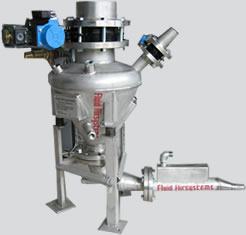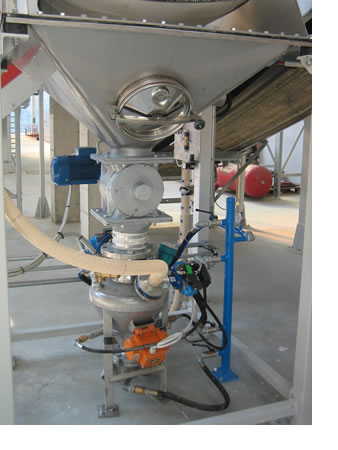
 |


Generally a pneumatic conveying system uses as a means of transporting a gas which is usually the air, this air taken from environment is sucked and returned compressed to a pressure and flow controlled insertions, dried and devoid oil (oil-free), depending on of the compressor used. For low pressures <1 bar, using centrifugal fans, impellers, vanes, copressori type root, for higher pressures <10 bar using a helical screw compressors piston etc..
We also know that among the powder transported there are some that are explosive, in these cases, instead of 'air using the' nitrogen (N2) as devoid of oxygen prevents the 'ignition of dust. An 'other case where it employs the' nitrogen is when the plant must be placed in a atex site, also in this case it is preferred to use the nitrogen (N2) as a gas for transportation.
We can divide the pneumatic transport in two categories: in dilute phase and dense phase.
The dilute phase is also known as transport flight. The material is transported in suspension in the air through the pipeline. The general characteristics of the typical dilute phase conveying are:
- High-speed is of the 'air of the material.
- Ratio material weight / air weight <10
- Pressure <1 bar
Therefore these charateristics we respectively in the case of abrasive, fragile and mixed materials phenomena of wear, breakage, demixing.
In the dense phase the material inside the pipe does not float but is deposited on the bottom of the duct riempedo in part or totally the tube itself. As a result we have:
- Low speed transport of both the 'air of the material
- Ratio weight material / weight air 20-100
- Pressure up to 6 bar too.
For these characteristics pneumatic conveying in dense phase are also called pneumatic conveying highpressure or pneumatic conveying low-speed. The advantages are obvious:
- High flow material rate
- Wear limited
- Low speed
- Low air consumption.
 In
general a pneumatic conveying system is composed of:
In
general a pneumatic conveying system is composed of:A- Section of load. This may be formed by:
- One or more storage bins: These can be built in painted carbon steel, stainless steel 304 or stainless steel 316 intalled inside or outside. They may have support legs or skirt, if equipped with corbels are supported by structures in steel profile. They can be arranged in single row or double or triple row. Usually are loaded Are equipped with: -
- Safety valve.
- Filter Vent,
- Load cells.
- Livel minimum and maximum
- Fluidisations.
- Access ladder and guard rails.
- Screw or rotary valve or slide valve or butterfly valve outlet.
- Transit hopper
- Automatic - semi-automatic - manual cut-bags with press empty bags.
B- Section we will call movement. Which includes:
An equipment for dosing and input the material in the pipeline. This equipment for pneumatic conveying in dilute phase can be an rotary valve or an venturi, an screw, an
vibrating feeders, etc.. There are different versions:
- The rotary valves to conveyor abrasive products have a rotor with the tips in vulkolan replaceable and chrome covers.
-The rotary valves which operate in environments or products very hot 50 ° C-100 ° C have the supports spaced from the valve body. The rotary valves quik disassemby is used when there 's need to ensure the absence of pollution between a product and the other.
When using screws to transport abrasive materials are used wear pads on the peripheral portion of the screw. For conveying sticky products it is preferred to build screw do not exceed a certain lengt to avoid intermediate supports of the tree that can cause blocking of equipment. The vibrating channel ensures a feeding of the product through the vibration produced by a vibrator. E suitable for transporting products in powder and granules even of large size. Abrasives and delicate. It may also carry products at high temperature. Fluid airsystems has successfully produced channels vibrated or vibratory feeders for products at high temperature (800 ° C) in highly corrosive environment (sulfuric vapors)
employing for the construction stainless steel 410.
For the dense phase pneumatic transport this equipment is constituted by the blow tank. The blow tank can be of various capacities as a function of the plant capacity and ranges from a few liters as in the case of the mini blow tank "EOLO" patented by Fluid airsystems that has a capacity of 5 liters and is used for the pneumatic transport of additives in small amounts. at different capacity. Usually the capacity of the blow tank varies from 24 to 60 Lt. , 100, 300, 400, 500, 600, 700, 900, 1000, 3000 ................ lt. and beyond. If two blow tanks in series are used , rather than one , a significatant improvement in performance can be achieved . While one is in charge, the other carries. The result is a dense phase transport almost "continuous", while a single blow tank works in batch.
The blow tank and equipped with various devices and control instruments such as:
Butterfly valve with actuator and limit switches
Digital Pressure
Indicator maximum level
Pulsed valve
Load cells if you want to send batch weighed.
C-The conveying line with its components:
- Pipe: is usually formed by rods commercali 6 meters long. The diameters vary from 1 "to 12" and over, as well as the thicknesses that vary from 1 to 10 mm. and more depending of 'use. The pipe may be of carbon steel, stainless steel 304 or 316, basalt, rubber, pvc, polyethylene, polyurethane, flexible or rigid. The various sectors of pipe are joined by flanges or couplings, quick couplings type "Victaulic" etc..
- Bends: can be 90 °, 45 °, 30 ° wide radius or low radius, made of different materials such as carbon steel, stainless steel 304 or 316, or materials resistant to wear such as the bends with replaceable wear back in Ni Hard Mod DN50-DN80-DN100-DN125 Fluid airsystems., or cobalt, rubber, etc..
- Diverters: equipment suited for conveying the material in different points of destination, there are different types depending on the system used to divert the material: blade diverter, diverter drum, slide switch 2 way, 3 way, 4 way, Mod DN50-DN80 Mod, Mod DN100. diverter stanchion which is constituted by a pair of val butterfly valves or pinch valves.
D-Separation Device
Normally, the and point of a pneumatic tconveying is represented by a silo or hopper or mixer, mix, dispersions or a loading bags, Mod Mod CR07-CR08. For the transport dilute phase pneumatic pressure in the device of arrival will be constituted by a cyclone separator, or from a silo with filter. If the filter has considerable size must be partialized, in this case a cell must always be in washing, to isolate the cell from the rest of the filter are used a slide valves also of considerable size. Fluid airsystems has provided slide valves diameter 800 mm. and slide valves diameter 1200 mm., controlled by hydraulic cylinder, built in stainless steel 316 L if the 'environment is corrosive. The purpose of these devices (Cyclone separator and filters) is to separate the air used for the conveying of the material.
In the case of pneumatic conveying in dilute phase in vacuum the separator device will be the same, the difference is that being in depression the device separetor (cyclon or filter) must be more robust.
For transport in dense phase there is no need of a cyclone separetor because the speeds are lower, it is enough a hopper volume proportionate to the blow tank and a small filter because the volumes of air is much lower than in dilute phase conveying (pressure or vacuum).
E- Dosage
The pneumatic transport not infrequently is used for feed weighing systems and dosage. The dosing is used where it must be dosed one or more of the products usually in powder or granule or flake with a certain precision in from a few grams (10-20 gr / Sec ..) to several kilograms (100-2000 kg / H ). The microdispenser is essentially composed of a feed hopper of a few liters and one or more screws placed at the bottom. The microdosers can be volumetric or gravity depending on whether dosing via srew or by subtraction of weight of load cells.
FIELDS OF USE
The pneumatic transport is widely used for years in almost all fields where it is present in the raw material in powder or granule.
Chemical industry where you use titanium dioxide, calcium carbonate, talc.
Food industry where you use sugar, cocoa, flour, coffee granules, ground coffee.
Pet food, for the pneumatic conveying of the dry food for animals in different sizes.
Plastics industry where you use pvc pvc powder and granules, polyethylene granules and polyethylene powder, polythene, polystyrene, nylon.
Plastics moulding industry (rotomoulding) Where to use polythene powder low and high density.
Pharmaceutical industry for the production of antibiotics.